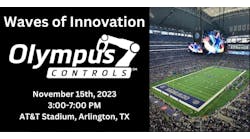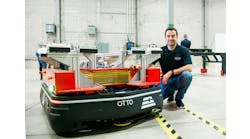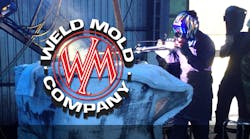On the occasion of Weld Mold Co.’s 60th year in operation, Forging interviewed Darryl S. Hammock, chief executive officer, about the Brighton, MI, company’s history and current operations.
Weld Mold manufactures high-alloy welding electrodes, flux-cored wires, and solid wires for maintenance & repair, tool & die, stainless steels, forging, and hard-facing applications. It claims to have developed more than 3,000 products and sizes, using its own R&D metallurgical department to prepare special electrode and flux-cored alloys to suit customer requirements.
Tell us about the origins of the company.
As we enter our 60th year in business, I want to recognize one man, the father of our welding rod, Matt Kiilunen (1905-1990). His efforts to increase die life for an industry that he loved continue today in our operations at Weld Mold Co.
Kiilunen started Weld Mold Co. in 1945. “Matt the Welder” loved learning and solving great mysteries of tool steels and high-deposition welding, specifically for the forging industry. His “flood welding” products and patented equipment formed a welding process that revolutionized die welding and saved the forging industry untold millions of dollars—and continues to do so today.
What have been some of the major milestones along the way?
Since Kiilunen’s death, the company has gone through periods of turmoil. Despite it all, Weld Mold has returned as an industry leader and manufacturer of industry standard welding materials.
There are numerous welding facilities in the U.S. and worldwide that use and promote the Weld Mold Flood Welding process daily. There are worldwide welding operations specializing in die repair, forging-equipment component rebuild & repair, or both. Indeed, Kiilunen invented an industry that has supported many people and their families for a very long time.
Matt also started, funded or assisted in the start-up of a number of related and unrelated companies. For example, he founded one business to supply cored welding products to Weld Mold Co. That company, which remains in business but is no longer affiliated with Weld Mold Co., did a tremendous amount of damage to us and could have resulted in the end of our company with the actions it took in 1994.
During this time, our company faced the bleakest outlook possible: declining sales due to competition from our own supplier to our own accounts. We lost sales and scrambled the next few years to company in existence.
Business finally gained momentum again in 1998 when we began manufacturing the main cored-wire products we had previously offered through our captive supplier. Even today, we are rebuilding our recipe list of companion cored products for our main-line forging materials, maintenance & repair, tool steels, hard facing, and specialty electrodes & solid materials.
The mid-1990s were years of dramatic change. Besides the cored wire capabilities coming on-line, we completed our ISO registration, the first fully implemented quality system in the history of the company.
We went online with our website, we cleaned and painted our facility and upgraded our equipment and manufacturing processes. We brought in 40-foot dumpsters and disposed of years of useless accumulations.
We hired staff-level managers to help us transition into a more professional organization. Lean Manufacturing forced us to pay particular attention to our manufacturing processes and manpower. We installed a new computer operating system to implement scheduling and inventory control, full traceability, and documented production and process control. We began organized and systematic training, some financed through outside grants.
As time goes on, we’ll work to eliminate the mounds of paper we generate with our paperless system. A state-of-the-art imaging system is the latest shift toward a totally paperless system. The majority of our information is now stored electronically and accessed with local terminals throughout our plant.
Can you give us more detail about your transition into the Weld Mold Co. of today and its product offerings?
Kiilunen and Weld Mold Co. invented the welding processes for repairing forging dies and components repair. Initially, we welded to test the welding materials and processes we developed.
This evolved into the die-welding industry as we know it now. However, we were unable to maintain the focus needed to operate a welding operation while at the same time maintain the development of welding materials, especially while working to replace a previous supplier.
We looked at aging welding equipment, retirements, and a welding facility that was too large for the amount of work we were doing. There was also strong competition from companies whose only focus was die welding. We closed down our welding operation in 1998, so we no longer compete with our customers for welding service work, but we have an additional market for our products. In fact, our former largest competitor in welding is now one of our best customers.
After a visit to a progressive forge shop, we recognized the merits and necessity of Lean Manufacturing. With reduced sales, it was necessary to determine ways to reduce manufacturing costs, improve quality, and improve morale–all with fewer people. Some long-term employees left because they did not want to change. This scenario is common with Lean Manufacturing and 5S training. We often heard: “We used to do it this way and it was successful, so we ought to do it this way now.”
It took years to show our valued employees that our market had changed so drastically that we could no longer do business the way we used to. We had to change if we wanted to survive. We had to change because times had changed and we were rapidly moving into a world economy with markets and competition from countries that we could have only imagined previously.
Tell us about your business philosophy today.
Our strategy remains the same as the one that built this company. We specialize in products that are non-production, high-alloy, or special-alloy materials, and short-run and job-shop items. We manufacture 100 to 50,000-pound production runs of coated electrodes from 1/16 to 3/4 inches in diameter (commonly referred to as the “baseball bats”); cored wires for MIG and TIG; and thermal spray applications from 1/28 through 3/16 inches in diameter; and solid tool steel and miscellaneous spooled wires from 0.030 through 1/4 inches in diameter for MIG or cut lengths for TIG welding.
Today, we have over 3,000 products and sizes available, and most can be delivered within 72 hours. We pride ourselves on our efforts to develop rapidly new or modified alloys. To maintain this level of responsiveness to the marketplace, we maintain $1 million in finished inventory and raw materials.
What is the future for Weld Mold Co. and for welding forging dies?
For Weld Mold, 2004 was a banner year with new accounts, and Supplier of the Year awards from the world’s largest manufacturer of trucks and the world’s largest manufacturer of diesel engines. We have successfully entered new markets that will improve our business for years to come. And, we have built international markets for our products and services that are envied by our competition. This is a compliment to Weld Mold Co., our people, and our abilities. As tough as times were, the changes in our industry made us stronger.
We will continue working to carry on the tradition of Matt Kiilunen. If a forging company is looking to reduce the cost of die steel for its hammer or press dies by 10 to 30%, increase die life by 50 to 100% or increase the life of its open hammer dies by 700%, then the products and processes developed by Kiilunen might solve these problems.










